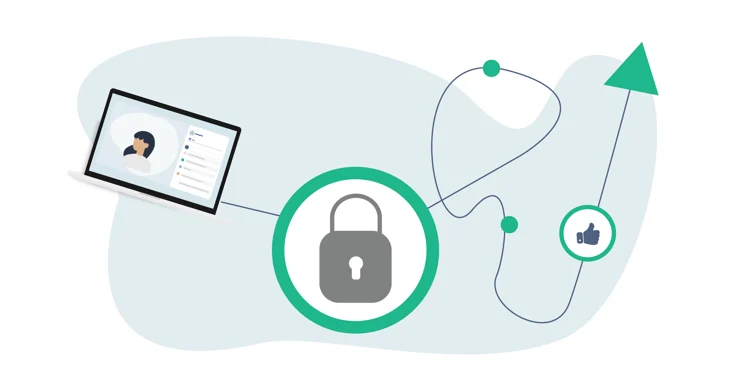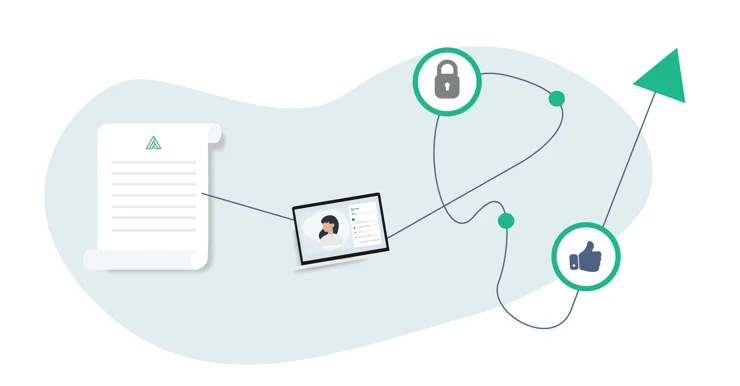How to write a Social Media Policy for employees

Many companies encourage employees to engage with company posts on social media, but this also means that companies need to come up with a social media policy for employees. That way, employees are not left in the dark, and they know what’s expected of them and how best to represent their company’s interests on social platforms. Keep reading for Ambassify's tips on how to write a social media policy for your own employees and advocates!
In 2018, Hootsuite surveyed more than 9,000 B2B and B2C companies from developed countries and found that more than 90% use social media to increase their visibility, strengthen their brand, and drive revenues up.
A lot of these companies encourage their employees to participate in social media activities. And this helps them accomplish three critical things:
- Increase organic reach and access to new audiences
- Strengthen employee advocacy and grow the employer brand
- And increase trustworthiness by connecting the brand to its people
What is a social media policy for employees?
A social media policy for employees is a living, breathing document that sets the guidelines for social media interactions. It mainly covers corporate use but will often incorporate some common sense principles that employees need to adhere to when interacting with their accounts on social media.
We call it a living document because, to be effective, it needs to stay always up to date and accessible: social media platforms evolve and change all the time, so this document needs to do the same. Our recommendation is to keep things simple. Don’t focus on specific platforms but, instead, create interaction and communication guidelines that are clear to both social media managers and new hires.
If you want your employees to help build on your social media success, you need to design a policy that encourages them to become brand champions.
This means that your policy is more than just a list of “don’ts” — it’s a clear and detailed document that outlines responsibilities and promotes participation.
Why is it important to have a social media policy?

A well-crafted social media policy is a must for companies that regularly ask their employees to participate in conversations on social networking sites.
The more apparent benefits of having one include:
- Preventing security breaches
- Staying in compliance with laws and regulations
- Maintaining consistent brand identity across channels
- Empowering employees to engage in advocacy
- Allowing for timely and appropriate responses in crises
However, one benefit we don’t hear about enough is the positive impact of a social media policy on your employer brand. This is your chance to set yourself apart from competitors — social media is a big part of people’s lives these days, so, naturally, employees don’t like guessing where their company stands when it comes to that.
A non-restrictive policy that encourages participation and involvement can go a long way in signaling how much individuality and transparency are valued in the company.
Most millennials and Gen-Z employees will think twice about working for a company that stifles their natural communications outlet, so it’s a good idea to advertise that, yes, you do have some rules. Still, you also acknowledge that spending time on social networks can be good for the business (and mental health in the workplace).
But this is also an opportunity to tell employees how they can go above and beyond — while you don’t want (and can’t) demand advocacy from your employees, you can use your social media guidelines as an opportunity to define expectations.
You can have a whole section on how to share content on different platforms and stress which content should get prioritized, whether it be employee stories, company culture stories, open positions, and similar. Additionally, you can mention your employee advocacy solution here and use the policy as a springboard to get people to sign up.
Now let’s take a look at how you can design a truly comprehensive and clear social media policy for employees — one that will help you to quickly collect on all the good things that come with it!
Encourage social media sharing among your employees with a centralized tool
Tour our platform in a few minutesDefine social media roles and responsibilities

Encouraging all employees to participate in social media conversations is one thing, allowing those conversations to get away from you is entirely different.
To avoid that — and protect yourself and your employees — you need to define social media roles and responsibilities clearly. In addition to clarifying who can speak on behalf of the company, make sure that you match the following duties to specific job descriptions:
- Daily posting and engagement activities
- Daily customer service
- Approvals (legal, marketing, and other)
- Paid promotions
- Crisis management and response
- Long-term social media strategy
- And social media training for rank-and-file employees
Depending on the size of your operation, it might be possible for you to be more or less restrictive and train more (or all) of your employees to provide satisfactory customer service or defuse crises.
If that’s not an option, make sure that your social media policy for employees states that you have a better-equipped team to handle these delicate interactions.
Compliance with the law and the internal code of conduct

There are several legal considerations that companies need to think about when posting and interacting on social media.
- Copyright and sources. The fact that something is online and accessible does not make it free. When posting 3rd party videos, photos, or quotes, make sure that your employees respect copyright laws.
- Privacy and disclosures. Be particular when it comes to information that’s considered confidential and off-limits to public discussion. This includes proprietary company data, sales trends, financial information, forecasts, future promotional activities, customer information, and more.
- Other regulatory challenges. Some industries (finance, healthcare, government, and similar) are tightly regulated and have specific social media rules that need to be followed. Summarize those rules in your social media policy for employees, and advise employees to check in with the legal department when in doubt about something.
We’re not big fans of over-regulation of personal social media use. Employees have a right to talk about their company and their job wherever they want as long as they are not lying or disclosing confidential information. However, it’s still worth it to tell your people how their social media behavior reflects on the business.
We suggest including the following guidelines in your policy:
- Remind employees that hate speech, threats of violence, harassment, or racial slurs are not tolerated.
- Ask them to disclose their affiliation if commenting on something related to the company, their job, or a competitor.
- Suggest that they add a disclaimer to their personal profile stating that their opinions are their own and do not speak for their employer.
- Remind them that the internet doesn’t have a “delete” button, and therefore should treat everything they put out there as permanent and think before they post.
Encourage brand conversations and social media advocacy

Often, a company’s social media policy will be heavy on the “don’ts” — don’t do this, don’t say that, don’t disclose information, don’t argue with customers, and similar. Often, employees will take a look at this and think: “Right, I better not talk about anything company-related because I might get into trouble.”
This is the last thing you want. You want your employees to engage with your audience and to share company content with their networks, but that means that you need to teach them how to do it appropriately.
What should be included in a social media policy?
Here are a couple of things you can include in your policy that might help with this:
- Educate employees on brand representation. Train them in company tone and voice and why they must stick to them when talking about the brand or sharing company content.
- Encourage content sharing. Use a dedicated employee advocacy platform to get your content in front of your employees and make it easy to share it with their networks.
- Incentivize important tasks. If you’re asking your employees for something more than a simple social media share, it’s a good idea to offer something in return. While you won’t address this specifically in your social media policy document, have a link there that leads them to a page where they can learn more about your incentivized employee advocacy program.
- Emphasize bringing value to all interactions. Make sure that your employees respond by adding value — links to content that answers customer questions or advice on what channels to use to get a solution to their problem faster.
Have a plan for conflict, PR, and security crisis situations

The purpose of a social media policy is to minimize employee-initiated conflict situations. That said, there’s only so much that you can do to prevent a PR disaster from spilling over on your social pages.
Essentially, this is a plan that, when activated, suspends your regular social media activities and hands over the reins to crisis management professionals who are better equipped to deal with these kinds of situations.
Your social media crisis management plan needs to include an up-to-date list of emergency contacts — including your social media team, crisis management team, legal department, PR department, and C-suite executives — who will spearhead and oversee the recovery efforts.
Since this is a sensitive document that will include information on what qualifies as a crisis and how to define the scope, as well as spell out an approval process for response activities, it shouldn’t be public-facing (e.g., not available on your website as most social media guidelines for employees are).
Keep your employees and brand safe

Social sites generally have tight security, but this doesn’t mean that there are no criminals or scammers out there. Phishing scams and ransomware attacks are common, so your social team and employees need to know how to defend against them.
Consider including the following security advice in your company’s social media guidelines for employees:
- What is considered a secure password, and how to set it up (or who to contact to set it up)
- How to set up two-way authentication for brand and personal accounts
- How to update devices and software to avoid security risks
- What are the common security risks, and how to safeguard against the
- Who to contact in case of a potential security breach (loss of a device, loss of password, unauthorized login, and similar)
Dial-in on success with social media guidelines for employees

Social media platforms are a powerful tool in your company’s bag of marketing tricks, but if your employees don’t know how to use them correctly, they could be setting themselves up for failure.
Advising them to avoid social media altogether won’t work either — this has been the preferred route of many companies over the years because it meant not having to deal with compliance or security issues. The downsides of this decision are many, and they include the loss of potential clients and visibility, which is precious and hard to come by these days. Not to mention the fact that you’ll be way behind your competition at this point, and this is not something you want to risk.
Creating a focused social media policy for employees can minimize the risk of breaches and flops and put your employee ambassadors to work.
Remember, in terms of website traffic, you’ll get up to 1000 times more web visits coming in from content shared by your advocates than from what you share through your corporate accounts. That alone is worth the time and effort you put into making sure that everyone is on the same page when it comes to social media.